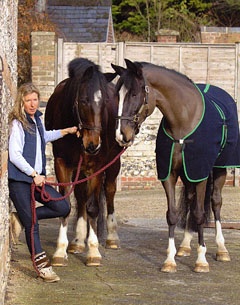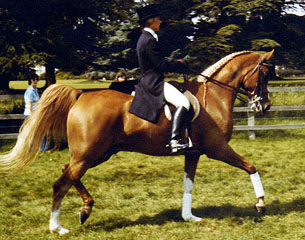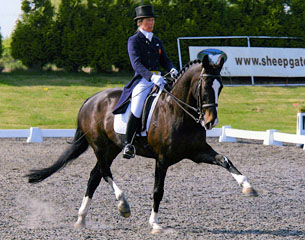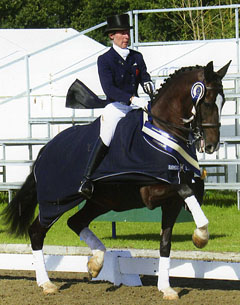
They are known as the biggest equine breed in the world. the Shire Horse is a magnificent giant with long feathers, once bred to pull a plough which became the backbone of the British farming community 100 years ago. Today the breed, which was feared to die out after the tractor took over after World War II, is popular amongst pleasure riders
and still used for pulling the beer drays of famous breweries in Great Britain and abroad. Definitely no one will consider a Shire Horse as a dressage prospect and probably no one would cross this breed with a thoroughbred with producing a Grand Prix dressage horse as serious aim. Still two Shire crossbreds managed to do become respected dressage horses: Walter and Giddy.
Walter, a 1992 born gelding and Giddy, a 1996 born mare, were both sired by thoroughbreds out of Shire Horse dams. Both had inherited the colour and typical white stockings of their coldblood ancestors and were an accomplished combination of these very opposing breeds.Walter was the first of British Olympic dressage rider Carol Parson’s two Shire crossbreds that climbed the ladder up to the highest levels and surprised the dressage public by doing very well at it. Not long after his stable mate Giddy joined him at the highest echelons of the sport. Both competed successfully alongside each other for a few years.
 Walter was sired by the famous thoroughbred It’s Without Doubt, which was bred by Diana Scott and standing at her Brendon Hill Stud for many years. This noble chestnut unified outstanding eventing bloodlines being by Welton Louis out of Doubtless by Ben Faerie xx, a full sister to Ginny Elliot’s (née Holgate) legendary World champion Priceless. It's Without Doubt also sired the Olympic eventer Sir Toby whom Marina Köhncke rode in the German team in 2000.
Walter was sired by the famous thoroughbred It’s Without Doubt, which was bred by Diana Scott and standing at her Brendon Hill Stud for many years. This noble chestnut unified outstanding eventing bloodlines being by Welton Louis out of Doubtless by Ben Faerie xx, a full sister to Ginny Elliot’s (née Holgate) legendary World champion Priceless. It's Without Doubt also sired the Olympic eventer Sir Toby whom Marina Köhncke rode in the German team in 2000.
So despite his heavyweight mother Walter had lots of performance blood which surely helped in his training. Diana Scott remembered Walter very well as she herself breeds the odd Shire crossbred: “It’s Without Doubt was an exceptional mover for a non warmblood and sired several good dressage horses. Walter was bred out of a most unlikely Shire type mare which was not a pedigree Shire. The owner was Mrs Dee Olof who came from somewhere near Axminster. I have always liked breeding the odd Shire cross and keep one mare for that purpose. They are very active movers and produce good jumpers as well. This gives one a varied market to sell youngsters on and there is always a lack of good heavyweight jumping hunters."
 Walter was also bred for the popular and big hunting market in Great Britain and for sure was never intended to end up where he belonged to later. Like with so many horses not specifically bred for the discipline of dressage it needs lots of luck to find a rider capable and willing to work with an untypical breed to bring them into the limelight. Walter was lucky to meet Carol Parson, who rode the conventionally bred KWPN horse Vashkar at the 1992 Olympics in Barcelona. Carol, an accomplished dressage rider, had already trained a pure bred Arabian called Golden Wings to Grand Prix dressage in the 1970s, but limited funds in the mid 1990s forced her to look for cheaper dressage prospects than the cherished European warmblood.
Walter was also bred for the popular and big hunting market in Great Britain and for sure was never intended to end up where he belonged to later. Like with so many horses not specifically bred for the discipline of dressage it needs lots of luck to find a rider capable and willing to work with an untypical breed to bring them into the limelight. Walter was lucky to meet Carol Parson, who rode the conventionally bred KWPN horse Vashkar at the 1992 Olympics in Barcelona. Carol, an accomplished dressage rider, had already trained a pure bred Arabian called Golden Wings to Grand Prix dressage in the 1970s, but limited funds in the mid 1990s forced her to look for cheaper dressage prospects than the cherished European warmblood.
"I have always had to 'make do'," Carol told Eurodressage. "Expensive warmbloods were out of reach financially, so it came as no surprise to me to try it with a Shire-crossbred. I met Walter when I answered an add in Horse & Hound buying the half-brother of my later mare Giddy and went back to buy Walter as well. Giddy I bought there when she was two after I had seen her at foal age. Although they were no typical dressage warmbloods they all had three good basic gaits, good enough for me, so I bought them all with the purpose to train them to Grand Prix," she reported.
Both of her Shire crossbreds needed work on the trot. Very opposite to a modern warmblood neither Walter nor Giddy had bouncing gaits. Instead they had inherited the typical powerful Shire shoulder. These horses were more on the forehand because they were produced to pull forward instead of carrying upwards.
 The main focus was bringing both horses off the forehand and initiate more engagement from the hindquarters, resulting in an improved self- carriage. At the beginning they had a very earthbound trot and one couldn’t even think of them doing an extended trot at that stage of their training. The power and suspension Walter and Giddy showed as advanced dressage horses was entirely the result of their training and proof that dressage can do a lot with a horse lacking natural talent for the discipline.
The main focus was bringing both horses off the forehand and initiate more engagement from the hindquarters, resulting in an improved self- carriage. At the beginning they had a very earthbound trot and one couldn’t even think of them doing an extended trot at that stage of their training. The power and suspension Walter and Giddy showed as advanced dressage horses was entirely the result of their training and proof that dressage can do a lot with a horse lacking natural talent for the discipline.
"In principle I trained them the same way as any other horse. But to produce self-carriage and engage their hindquarters I worked more on transitions within one pace. I had to change their natural way of going, especially in the trot. As soon as they were able to carry more weight on the hindquarters and lift the shoulders the trot improved. But the extended trot only really came once the passage was established."
The strong powerful coldblood shoulders definitely had been a real disadvantage concerning the extended movements, but on the other hand absolutely helped to teach them piaffe and passage.
"They both found piaffe and passage, but also the pirouettes easy and were always marked highly for it. Giddy became famous for her piaffe and passage and the transitions in and out. She had such a huge presence in the arena that people always thought her to be much bigger than her 16 hands," Parsons stated.
Carol didn’t mind the real disadvantage in training the two Shire crossbreds through the dressage levels. She was convinced right from the beginning that both horses would go all the way "and do well." Walter reached that level at 10 and Giddy was only 9 years old when she made it to Grand Prix.
 Great Britain might be the “horsiest” nation in the world and what really counts there is the performance of a horse, not its look or breed - much more so than on the continent. On the one hand this open-minded approach towards untypical horses or crossbreds has helped bringing non-dressage breeds into the FEI arena, but on the other hand it is of course also a question of financial possibilities falling back on such horses. One can assume that no dressage rider would go the more difficult way to Grand Prix with a horse not specifically bred for the job, if funds were available to buy a fancy moving and meticulously bred dressage prospect. However, the value of a rider’s work, who trains a less talented horse to the highest levels, can be esteemed greatly because of the met challenges and difficulties.
Great Britain might be the “horsiest” nation in the world and what really counts there is the performance of a horse, not its look or breed - much more so than on the continent. On the one hand this open-minded approach towards untypical horses or crossbreds has helped bringing non-dressage breeds into the FEI arena, but on the other hand it is of course also a question of financial possibilities falling back on such horses. One can assume that no dressage rider would go the more difficult way to Grand Prix with a horse not specifically bred for the job, if funds were available to buy a fancy moving and meticulously bred dressage prospect. However, the value of a rider’s work, who trains a less talented horse to the highest levels, can be esteemed greatly because of the met challenges and difficulties.
Though both type of dressage horses can do well and be successful the typical warmblood has undeniably advantages which can influence the result positively: "I believe the big loose warmblood that is perhaps not so active behind will be forgiven this in a test over something like a Shire crossbred which is very active, but can get tight through the frame. This becomes very noticeable because they are not blessed with the looseness in first place," Carol opined.
Still sje doesn’t feel the judges were ever unfair to her or biased because they were a bit different from what they usually see.
 The crowds, however, admire 'different horses.' They loved the Shire crossbreds. "Giddy especially has a big fan club," Parsons admitted. Walter and Giddy not only managed to become Grand Prix horses, but were successful up to CDI-level. Among his remarkable results Walter placed 5th in the Grand Prix and the freestyle at the CDI Hickstead in 2004 and came 3rd at the British Dressage Championships in 2005 at Inter II level. Giddy was 2nd at the Nationals in 2005 and 2006 and even became the Hickstead Dressage Masters champion in 2008.
The crowds, however, admire 'different horses.' They loved the Shire crossbreds. "Giddy especially has a big fan club," Parsons admitted. Walter and Giddy not only managed to become Grand Prix horses, but were successful up to CDI-level. Among his remarkable results Walter placed 5th in the Grand Prix and the freestyle at the CDI Hickstead in 2004 and came 3rd at the British Dressage Championships in 2005 at Inter II level. Giddy was 2nd at the Nationals in 2005 and 2006 and even became the Hickstead Dressage Masters champion in 2008.
Even though Carol has long proven to be able to work with all breeds in dressage and even though she is well known and admired for bringing Walter and Giddy on, her best horse so far had been Vashkar, the KWPN gelding whom she rode at the 1992 Olympics.
"Right now I am looking to buy a decent warmblood, not a Shire crossbred again, but it becomes all the more difficult these days because of limited funding," Carol confessed. Both Walter and Giddy are retired from Grand Prix now. At age 20 Walter is used as a schoolmaster to teach students the Grand Prix movements and the 16-year old Giddy is still competed, but at PSG level with a Young Rider.
"Both are fit and healthy having worked very hard since they were four," said Carol. She has shown that serious dressage training not only enables untypical horses to become successful, but staying sound for a long time.
Text by Silke Rottermann for Eurodressage
Photos courtesy Carol Parsons
Related Links
Against All Odds: Balagur, an Orlov Trotter in the Olympic Dressage Arena
Against All Odds: Airthrey Highlander, a Clydesdale Crossbred at Grand Prix in New Zealand
Against All Odds: Seldom Seen, a Connemara Crossbred Going All the Way